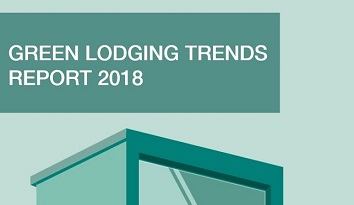SINGAPORE—Greenview has released its 106-page Green Lodging Trends Report 2018. The Report is the lodging industry’s annual exercise to assess and catalyze green innovation, best practices, and awareness regarding the state of sustainability across hotels worldwide. The Report highlights and summarizes responses to 115 survey questions in these categories: Energy Management, Waste Management, Water Conservation, Health & Wellness, Back of House, Communications, Staff Involvement, Community Involvement, and Climate Action & Certification.
 Greenview received data for 4,544 hotels across 61 countries. Of the overall data set, 2,202 properties were classified as City/Urban Hotels, 814 as Suburban Hotels, 607 as Resorts, 296 as Small Metro/Town, 258 as Airport Hotels, 211 as Convention/Conference Centers, 66 as Bed & Breakfast (B&B) Hotels and 11 as Serviced Apartments (the remainder of the properties are unidentified). A total of 2,271 properties of the data set were in Asia-Pacific, 2,127 in the Americas, and 146 in Europe, the Middle East and Africa. In terms of service type, 2,564 (56 percent) properties were classified as full-service properties, and 1,954 (43 percent) were classified as limited service (the remainder <1 percent properties’ service type is unidentified).
Greenview received data for 4,544 hotels across 61 countries. Of the overall data set, 2,202 properties were classified as City/Urban Hotels, 814 as Suburban Hotels, 607 as Resorts, 296 as Small Metro/Town, 258 as Airport Hotels, 211 as Convention/Conference Centers, 66 as Bed & Breakfast (B&B) Hotels and 11 as Serviced Apartments (the remainder of the properties are unidentified). A total of 2,271 properties of the data set were in Asia-Pacific, 2,127 in the Americas, and 146 in Europe, the Middle East and Africa. In terms of service type, 2,564 (56 percent) properties were classified as full-service properties, and 1,954 (43 percent) were classified as limited service (the remainder <1 percent properties’ service type is unidentified).
The responses do not represent the full data set, as participants were not required to answer all questions. The full data set also includes integration from other sources to augment the missing regions and hotel types. Participants received an insightful Benchmarking Report with further peer analysis by location and market segmentation across all the best practices surveyed. One of the objectives of the Report is to establish a benchmark against which one can compare one’s own property from year to year—whether that is against one’s own progress or that of other similar properties. While impossible to tell the individual stories of thousands of properties, this Report includes examples of best practices in action throughout the world.
Best Practices Examples Highlighted
The Report includes examples of best practices as well as graphs that include results broken down by region and property type. The following are examples of just some of the highlights from the Report:
- Eighty percent said more than 90 percent of their guestrooms have occupancy sensors.
- A total of 82.7 percent have over 75 percent of their hotels’ interior space equipped with LED light bulbs, up from 2017 (70.1 percent) and 2016 (54 percent).
- 21.4 percent of hotels have on-site renewable energy.
- 32.5 percent have electric vehicle charging stations installed, an increase of 6 percent since last year.
- 53.1 percent place recycling bins in guestrooms, an increase since 2017 (43.8 percent) and 2016 (42.6 percent).
- 58.5 percent have bulk soap and shampoo dispensers in over 90 percent of their guestrooms. This practice is more prevalent in Asia Pacific (63.2 percent) than in EMEA (39.2 percent) and the Americas (23.2 percent).
- 69.7 percent have low-flow showerheads for over 90 percent of the guestrooms.
- 26.1 percent capture rainwater for property use.
- 72.4 percent target travelers who are concerned about health and wellness in their marketing.
- 41 percent offer portable air purifiers in guestrooms upon request or in designated rooms for guests with allergies or chemical sensitivities.
- 51.2 percent have a linen/towel reuse program in place that offers guests the option of opting out of housekeeping services altogether for one or more nights.
- 85.8 percent have a policy that requires procurement from local suppliers. This is an increase from 2017 (82 percent) and 2016 (74.4 percent).
- 42.5 percent grow food ingredients such as herbs or vegetables on-site.
- 55.3 percent have a space on their hotels’ website dedicated to sharing green practices. The adoption rate for this practice has increased since 2017 (51.4 percent) and 2016 (48.2 percent).
- Globally, 70.6 percent have a green team or sustainability management team.
- 70.6 percent give employees the opportunity to volunteer time and services during regular working hours.
- Globally, 8.9 percent purchase carbon offsets or renewable energy certificates.
Glenn Hasek can be reached at editor@greenlodgingnews.com.





